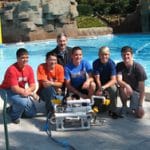Electronics and Robotics I & II Condensed
Course Description
Electronics Technology and Robotics II provides students with the knowledge, hands-on experience, and technical skill to:
Learning Outcomes
Year 1 – The course assumes the students know nothing about electronics or robotics so we start from scratch. The textbooks for the course are Electricity and Electronics by Gerrish, Dugger, Roberts and Robot Building for Beginners by David Cook since they cover the fundamentals of electronics and robotics and provide a hands-on robot project called Sandwich. The material on electronics is supplemented with additional information from numerous sources.
Year 2 – The course focuses on integrated circuits, including op amps, 555 timers, logic gates, PIC16F88 microcontroller, H-bridges, and sensors. The students design and build an autonomous robotic car and use a microcontroller for control of their robotic car. Different sensors are mounted to the robotic car as they are introduced. Basic Skill Requirements

Cornerstone Robotics
Instructor
Course Features
- Lecture Hours
- Lab Hours
- Credits
- Certification
- Language
- NSF ATE Funded
- 0
- 0
- 0
- None
- English
- No
